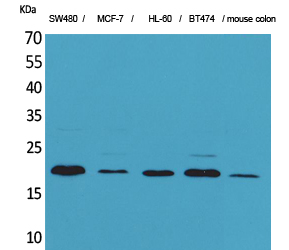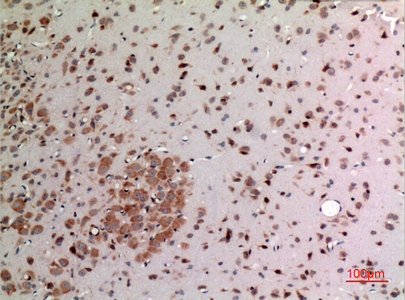FGF-20 Polyclonal Antibody
- Catalog No.:YT5178
- Applications:WB;IHC;IF;ELISA
- Reactivity:Human;Mouse;Rat
- Target:
- FGF-20
- Fields:
- >>MAPK signaling pathway;>>Ras signaling pathway;>>Rap1 signaling pathway;>>Calcium signaling pathway;>>PI3K-Akt signaling pathway;>>Regulation of actin cytoskeleton;>>Pathways in cancer;>>Chemical carcinogenesis - receptor activation;>>Melanoma;>>Breast cancer;>>Gastric cancer
- Gene Name:
- FGF20
- Protein Name:
- Fibroblast growth factor 20
- Human Gene Id:
- 26281
- Human Swiss Prot No:
- Q9NP95
- Mouse Gene Id:
- 80857
- Mouse Swiss Prot No:
- Q9ESL9
- Rat Gene Id:
- 66017
- Rat Swiss Prot No:
- Q9EST9
- Immunogen:
- The antiserum was produced against synthesized peptide derived from the Internal region of human FGF20. AA range:151-200
- Specificity:
- FGF-20 Polyclonal Antibody detects endogenous levels of FGF-20 protein.
- Formulation:
- Liquid in PBS containing 50% glycerol, 0.5% BSA and 0.02% sodium azide.
- Source:
- Polyclonal, Rabbit,IgG
- Dilution:
- WB 1:500 - 1:2000. IHC: 1:100-300 ELISA: 1:20000.. IF 1:50-200
- Purification:
- The antibody was affinity-purified from rabbit antiserum by affinity-chromatography using epitope-specific immunogen.
- Concentration:
- 1 mg/ml
- Storage Stability:
- -15°C to -25°C/1 year(Do not lower than -25°C)
- Other Name:
- FGF20;Fibroblast growth factor 20;FGF-20
- Observed Band(KD):
- 23kD
- Background:
- The protein encoded by this gene is a member of the fibroblast growth factor family. The fibroblast growth factors possess broad mitogenic and cell survival activities, and are involved in a variety of biological processes including embryonic development, cell growth, morphogenesis, tissue repair, tumor growth and invasion. This gene product is a secreted neurotrophic factor but lacks a typical signal peptide. It is expressed in normal brain, particularly the cerebellum, and may regulate central nervous system development and function. Homodimerization of this protein was shown to regulate its receptor binding activity and concentration gradient in the extracellular matrix. Genetic variations of this gene have been associated with Parkinson disease susceptibility. [provided by RefSeq, Oct 2009],
- Function:
- function:Neurotrophic factor that regulates central nervous development and function.,similarity:Belongs to the heparin-binding growth factors family.,tissue specificity:Predominantly expressed in the cerebellum.,
- Subcellular Location:
- Secreted .
- Expression:
- Predominantly expressed in the cerebellum.
- June 19-2018
- WESTERN IMMUNOBLOTTING PROTOCOL
- June 19-2018
- IMMUNOHISTOCHEMISTRY-PARAFFIN PROTOCOL
- June 19-2018
- IMMUNOFLUORESCENCE PROTOCOL
- September 08-2020
- FLOW-CYTOMEYRT-PROTOCOL
- May 20-2022
- Cell-Based ELISA│解您多样本WB检测之困扰
- July 13-2018
- CELL-BASED-ELISA-PROTOCOL-FOR-ACETYL-PROTEIN
- July 13-2018
- CELL-BASED-ELISA-PROTOCOL-FOR-PHOSPHO-PROTEIN
- July 13-2018
- Antibody-FAQs
- Products Images

- Western Blot analysis of SW480, MCF-7, HL-60, BT474, mouse colon cells using FGF-20 Polyclonal Antibody. Secondary antibody(catalog#:RS0002) was diluted at 1:20000

- Immunohistochemical analysis of paraffin-embedded rat-brain, antibody was diluted at 1:100

- Western blot analysis of lysate from SW480 cells, using FGF20 Antibody.



